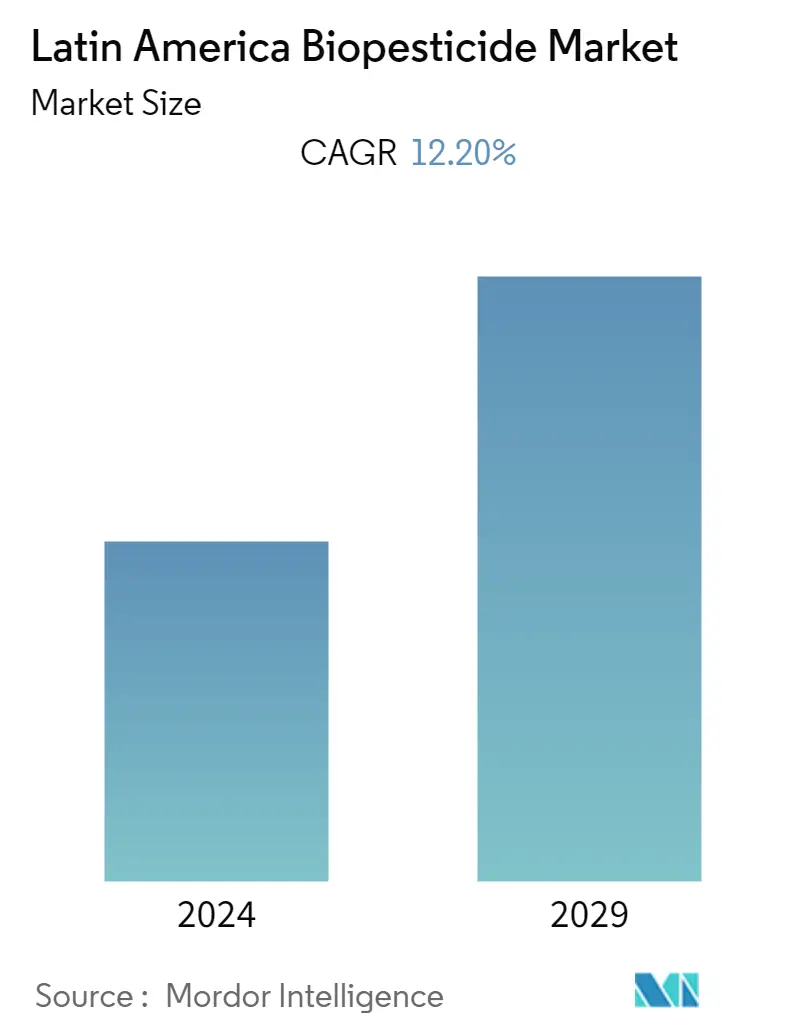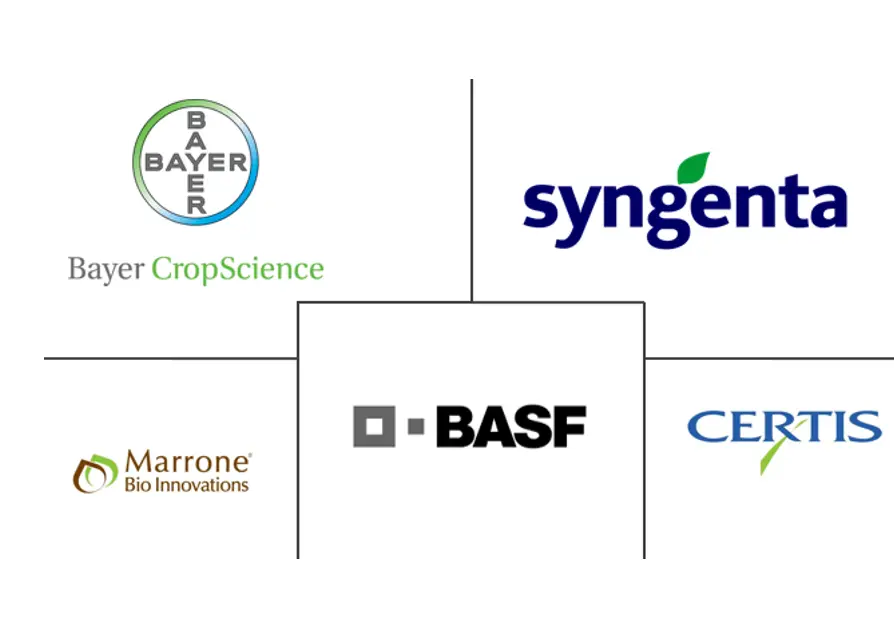Market Size of Latin America Biopesticide Industry

| Study Period | 2019 - 2029 |
| Base Year For Estimation | 2023 |
| Forecast Data Period | 2024 - 2029 |
| Historical Data Period | 2019 - 2022 |
| CAGR | 12.20 % |
Major Players
*Disclaimer: Major Players sorted in no particular order |
Latin America Biopesticides Market Analysis
The Latin America biopesticide market is projected to register a CAGR of 12.2% during the forecast period 2020-2025. In Latin America, the pesticide market, both synthetic as well as biopesticides are witnessing a steady growth and the key market drivers for the industry in the region are the adoption of herbicides tolerant crops, increasing area of crop production, and increasing yields of agricultural produce. However, strict regulations posed by the United States Environmental Protection Agency and European Union on pesticidal residue limit on food crops will limit the use of synthetic pesticides on crops and will increase the demand for biopesticides in the region. While the prevalence of chemical or synthetic pesticides in Latin America would continue, human, animal, and environmental health concerns would play key roles in driving growth for Biopesticides. Emerging economies of Latin America are likely taking the lead in the adoption of both pesticides and Biopesticides. Principal factors driving the same include greater adoption of biopesticides in place of traditional chemical-based pesticides as a consequence of increasing efficacy and enhanced consumer confidence in their performance output.
Latin America Biopesticides Industry Segmentation
According to EPA, 'Biopesticides are certain types of pesticides, derived from such natural materials as animals, plants, bacteria, and certain minerals.' The present study takes into consideration both microbial and organic pesticides. The market is broadly segmented into bioinsecticide, bioherbicide, bio fungicide, and others. The report presents a wide-ranging analysis of market share, size, and volume of the biopesticide market. The corporations in the biopesticide market operate in B2B, as well as B2C, format. However, to eliminate any 'double-count' error in market estimations, bulk buyers procuring these biopesticides for retail sale are, after value-addition through further processing, not considered within the market studied.
| Product | |
| Bioherbicide | |
| Bioinsecticide | |
| Biofungicide | |
| Others |
| Formulation | |
| Liquid Formulation | |
| Dry Formulation |
| Ingredient | |
| Microbial Pesticide | |
| Plant Pesticide | |
| Biochemical Pesticide |
| Application | |
| Crop-based | |
| Non-crop-based |
| Mode of Application | |
| Foliar Spray | |
| Seed Treatment | |
| Soil Treatment | |
| Post-harvest |
| Geography | |
| Brazil | |
| Argentina | |
| Rest of South America |
Latin America Biopesticide Market Size Summary
The Latin America biopesticide market is experiencing significant growth, driven by the increasing adoption of herbicide-tolerant crops and the expansion of crop production areas. The shift towards biopesticides is largely influenced by stringent regulations on synthetic pesticide residues imposed by entities like the United States Environmental Protection Agency and the European Union, which are encouraging safer agricultural practices. The region's emerging economies are at the forefront of this transition, as biopesticides offer a viable alternative to traditional chemical pesticides, addressing health concerns for humans, animals, and the environment. The movement towards sustainable agriculture is gaining momentum, with biopesticides playing a crucial role in reducing the environmental impact of farming while providing economic benefits to farmers and consumers alike.
The organic food industry in Latin America is witnessing rapid growth, fueled by a health-conscious consumer base that prefers organic products to avoid the adverse effects of chemical preservatives and genetically modified ingredients. This trend is driving the demand for biopesticides, as they are essential for the production of organic food. The market is characterized by intense competition among companies, which are not only focusing on product quality but also engaging in strategic initiatives such as new product launches, partnerships, and acquisitions to capture larger market shares. Major players in the market, including Valent Biosciences Corporation, Koppert BV, Certis USA LLC, Bayer Cropscience AG, and Syngenta, are investing heavily in biopesticide development, reflecting the growing emphasis on bio-based agricultural solutions.
Latin America Biopesticide Market Size - Table of Contents
-
1. MARKET DYNAMICS
-
1.1 Market Overview
-
1.2 Market Drivers
-
1.3 Market Restraints
-
1.4 Porters Five Force Analysis
-
1.4.1 Threat of New Entrants
-
1.4.2 Bargaining Power of Buyers/Consumers
-
1.4.3 Bargaining Power of Suppliers
-
1.4.4 Threat of Substitute Products
-
1.4.5 Intensity of Competitive Rivalry
-
-
-
2. MARKET SEGMENTATION
-
2.1 Product
-
2.1.1 Bioherbicide
-
2.1.2 Bioinsecticide
-
2.1.3 Biofungicide
-
2.1.4 Others
-
-
2.2 Formulation
-
2.2.1 Liquid Formulation
-
2.2.2 Dry Formulation
-
-
2.3 Ingredient
-
2.3.1 Microbial Pesticide
-
2.3.2 Plant Pesticide
-
2.3.3 Biochemical Pesticide
-
-
2.4 Application
-
2.4.1 Crop-based
-
2.4.2 Non-crop-based
-
-
2.5 Mode of Application
-
2.5.1 Foliar Spray
-
2.5.2 Seed Treatment
-
2.5.3 Soil Treatment
-
2.5.4 Post-harvest
-
-
2.6 Geography
-
2.6.1 Brazil
-
2.6.2 Argentina
-
2.6.3 Rest of South America
-
-
Latin America Biopesticide Market Size FAQs
What is the current Latin America Biopesticide Market size?
The Latin America Biopesticide Market is projected to register a CAGR of 12.20% during the forecast period (2024-2029)
Who are the key players in Latin America Biopesticide Market?
Valent Bioscience Corporation, Koppert Biological Systems, Bayers Crop Science, Syngenta and Marrone Bio Innovations are the major companies operating in the Latin America Biopesticide Market.

